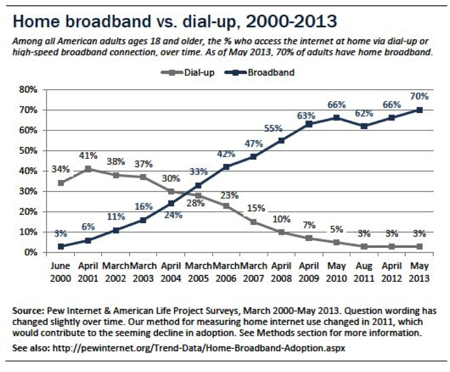How to Provide Broadband Access to 100 Million Americans
Despite the 70 percent of Americans with high-speed broadband access in their homes, 19 million Americans don’t have access and 100 million don’t subscribe to broadband. In fact, 20 percent of Americans have neither broadband nor a smartphone. As the chart below illustrates, dial-up connections have been steadily dropping since 2001, and broadband connections have seen steady growth.

In areas where broadband isn’t available, it’s clear that infrastructure investment — either from businesses, the government, or some combination of the two — is needed. But what about Americans who have access to broadband but choose not to subscribe?
One key issue is cost. Laying fiber is expensive for service providers, especially in rural areas where there aren’t many potential subscribers. For consumers, Internet costs are high, which is one reason mobile connections are growing quickly in rural areas. It’s simply easier for service providers to send signals wirelessly than to connect individual houses.
The map below shows which areas of the country have access and which don’t.
How to Get High-Speed Broadband Access to More People
Benjamin Lennett and Sascha Meinrath of the New America Foundation suggest that highways be expanded to deliver high-speed Internet access. Eric Jaffe explains on The Atlantic Cities:
Lennett and Meinrath argue that broadband access is a basic public service every bit as necessary as good roads. Since 90 percent of the country lives within 5 miles of a national highway, and since utility infrastructure is already planted along highway rights-of-way, bundling the network is the simplest and surest way for service to reach everyone.
"Our idea was that you create this open infrastructure, so that anyone could come in and provide connectivity," says Lennett. "It would be a public asset along the highway system."
The obvious benefit of such a system would be its national scope. Rural regions that private providers might consider unprofitable and ignore would gain broadband access, but remote areas wouldn't be the only victors. So-called "middle mile" access would improve, too, meaning Internet service in smaller cities and towns wouldn't have to go out of its way to reach big interconnection hubs in major areas, leading to faster speeds.
In addition to connecting people, Jaffe describes how this type of infrastructure upgrade would also help the Transportation Department’s push toward machine-to-machine networks and connected cars. “Laying fiber along the national highways would facilitate the arrival of this ‘smart’ roads system that DOT believes is the future of American car travel,” says Jaffe. It’s a bright idea, and one that deserves serious consideration.
For governments, digital services rely heavily on citizens’ Internet connections. The future of both cities and rural areas will require a more widespread adoption of broadband and an infrastructure strong enough to support a growing population.








